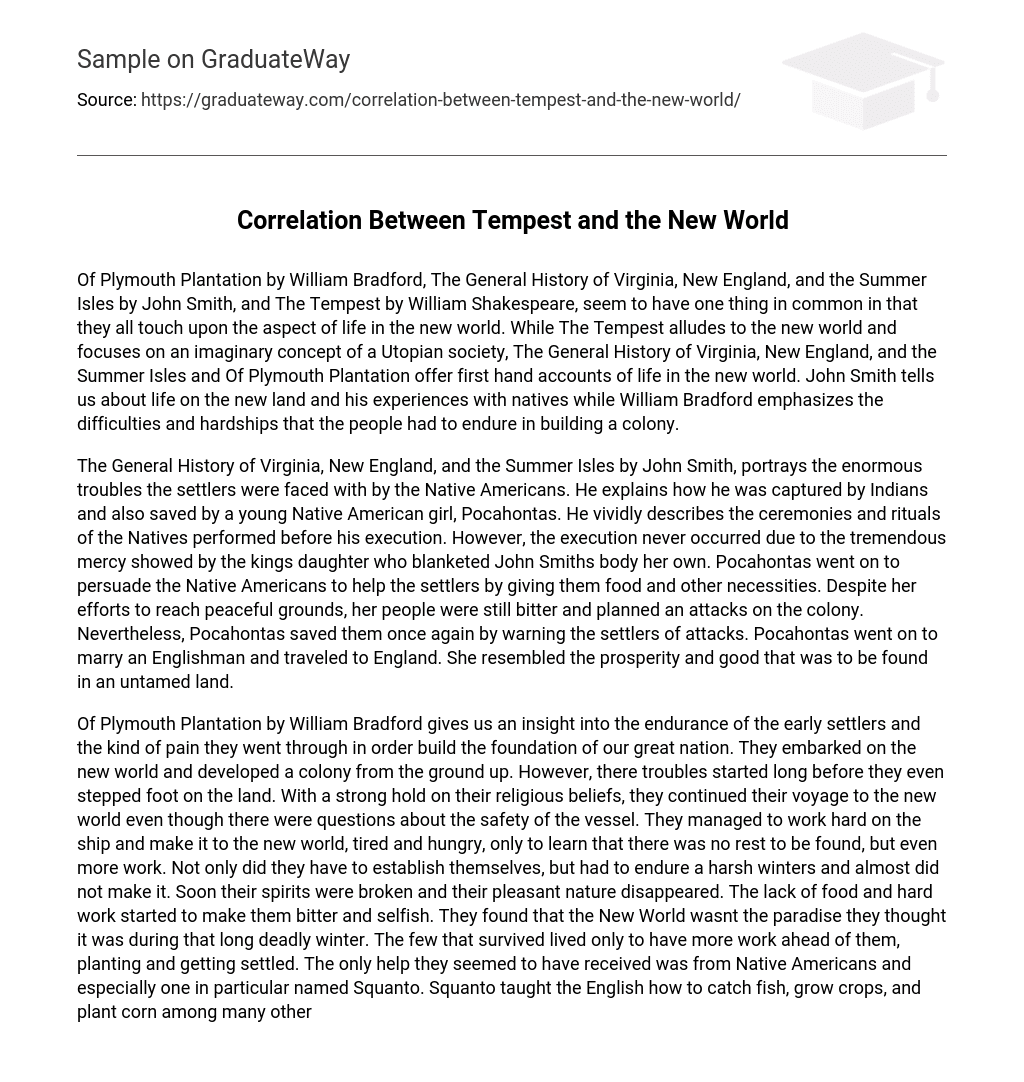Of Plymouth Plantation by William Bradford, The General History of Virginia, New England, and the Summer Isles by John Smith, and The Tempest by William Shakespeare, seem to have one thing in common in that they all touch upon the aspect of life in the new world. While The Tempest alludes to the new world and focuses on an imaginary concept of a Utopian society, The General History of Virginia, New England, and the Summer Isles and Of Plymouth Plantation offer first hand accounts of life in the new world. John Smith tells us about life on the new land and his experiences with natives while William Bradford emphasizes the difficulties and hardships that the people had to endure in building a colony.
The General History of Virginia, New England, and the Summer Isles by John Smith, portrays the enormous troubles the settlers were faced with by the Native Americans. He explains how he was captured by Indians and also saved by a young Native American girl, Pocahontas. He vividly describes the ceremonies and rituals of the Natives performed before his execution. However, the execution never occurred due to the tremendous mercy showed by the kings daughter who blanketed John Smiths body her own. Pocahontas went on to persuade the Native Americans to help the settlers by giving them food and other necessities. Despite her efforts to reach peaceful grounds, her people were still bitter and planned an attacks on the colony. Nevertheless, Pocahontas saved them once again by warning the settlers of attacks. Pocahontas went on to marry an Englishman and traveled to England. She resembled the prosperity and good that was to be found in an untamed land.
Of Plymouth Plantation by William Bradford gives us an insight into the endurance of the early settlers and the kind of pain they went through in order build the foundation of our great nation. They embarked on the new world and developed a colony from the ground up. However, there troubles started long before they even stepped foot on the land. With a strong hold on their religious beliefs, they continued their voyage to the new world even though there were questions about the safety of the vessel. They managed to work hard on the ship and make it to the new world, tired and hungry, only to learn that there was no rest to be found, but even more work. Not only did they have to establish themselves, but had to endure a harsh winters and almost did not make it. Soon their spirits were broken and their pleasant nature disappeared. The lack of food and hard work started to make them bitter and selfish. They found that the New World wasnt the paradise they thought it was during that long deadly winter. The few that survived lived only to have more work ahead of them, planting and getting settled. The only help they seemed to have received was from Native Americans and especially one in particular named Squanto. Squanto taught the English how to catch fish, grow crops, and plant corn among many other things. Squanto was a heavy contributor to the survival of the settlers in their early years in the new world. Once again, the face of the new world was saved by a Native American.
The Tempest by William Shakespeare embodies all the ignorant ideas the Europeans had of the new world. Though he never directly states that his work is in respect to the New World, there are a few allusions to which we can refer to, in order to endorse this idea. When the courtiers first get ship wreaked on the island, Gonzalo emphasizes the natural beauty of the island. This could be an allusion to the new world because the new world was portrayed to the Europeans as a utopia with a remarkable amount of natural beauty. Furthermore, Caliban himself can be seen as a reference to the new world in that he holds the incorrect conceptions of the natives the Europeans had at the time. The Europeans characterized the Native Americans to be savages much like Caliban. Similar to the Native Americans, Caliban would receive harsh punishments and would become enslaved. However, the main idea of the Tempest in reference to the new world seems to be the idealistic idea of a harmonious environment in a new land. This could not be any farther from the truth. The idiotic ideas that were held by Europeans about the New World were proven wrong in the both of the other two stories. The idea that the New World was a utopia was pushed far from its reality and that is depicted in the tremendous hardships faced by the new settlers. There lack of food, shelter, and necessities all add to the fact that the New World was just as normal as any other place on earth. Another idea expressed in the Tempest was the savage and inhumane nature of the Natives in regard to Caliban. However, in both stories, the settlers lives were saved due to the caring nature of the some Native Americans. Despite the natives help which was essential to their survival, they were soon attacked unmercifully and driven out of their own land.
These three works of literature enhance the modern day readers view as to what the New World was portrayed to be and the actual reality. The Tempest encompasses the idealistic views of the New World by the Europeans before their settlement. The General History of Virginia, New England, and the Summer Isles, as well as New England, and the Summer Isles show the harsh reality. Not much of the perceptions Old World held about the New World were correct. The idea that the Europeans would find a beautiful land and merrily settle without too much problems from natives or other hazards was not the case.
Bibliography:





